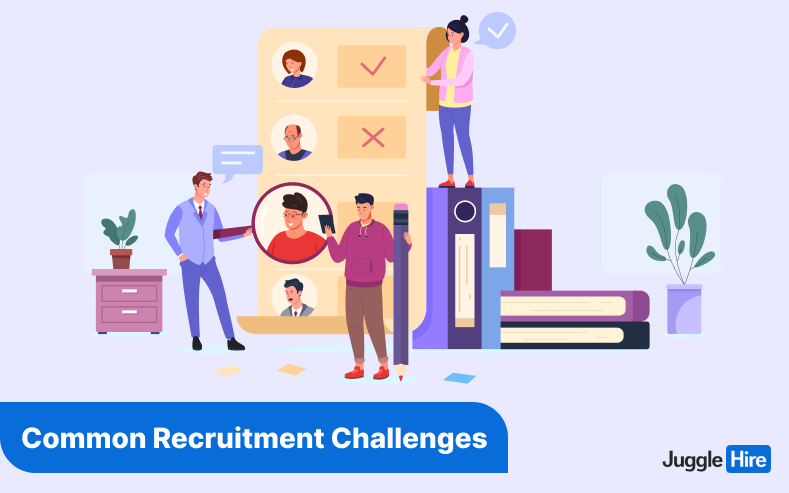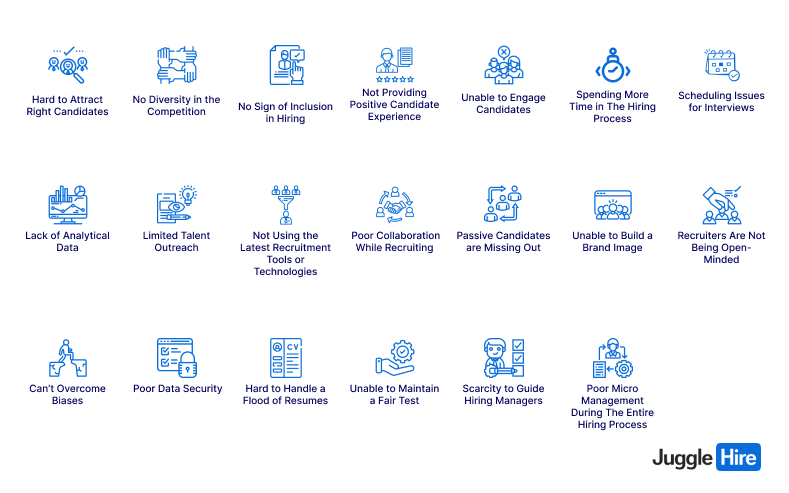20 Common Recruitment Challenges (+ How to Solve Them)

The way companies find people to work for them has changed a lot in the last few years. This change happened because technology got better and faster. So, recruitment challenges are increasing more than ever.
Believe it or not, almost 76% of recruiters say hiring the right candidate is their biggest challenge.
Glassdoor Research Report
Therefore, recruiters, hiring managers, and recruitment teams still encounter persistent challenges even in this modern age. They can’t attract, engage, and hire the right candidates for organizational growth. If you are also grappling with recruitment challenges, you may probably look for effective ways to handle them.
With that in mind, we will discover the common 20 recruitment challenges and solutions. We will offer insights, best practices, and tips to overcome them.
Which Situation Makes The Recruiting Job More Challenging

Finding people for jobs can be harder now because of different reasons. Sometimes, it’s because of how workplaces are set up and the rules they have. One big problem is that now companies want very specific details about the jobs they’re hiring for. This makes it tough for recruiters to find the right people who fit all those requirements.
In some organizations, policies mandate promotions from the inside. In that case, it narrows down the pool of candidates for external hires. Internal promotions foster loyalty and motivation among existing employees. However, recruiters face the challenge of finding external candidates who can bring fresh perspectives to the team.
Another factor adding complexity is the need for reverse discrimination. A balanced workforce can’t be achieved without it. While promoting diversity is essential, recruiters must solve this problem to maintain fairness in the hiring process. Otherwise, they can’t create an inclusive environment.
Interestingly, the abundance of qualified candidates for each position can pose a unique challenge. Although having a talent-rich pool is beneficial, it increases the workload for recruiters due to extensive paperwork. Plus, they need meticulous candidate evaluation to make the best hiring decisions.
20 Recruitment Challenges Companies Still Face Today

Hiring managers have faced plenty of challenges when we analyze past, present, and future experiences. With that said, recruiters still face the following problems, even today:
01. Hard to Attract Right Candidates
There is a sea of unqualified talent. Around 63% of hiring professionals deal with talent shortages. Hence, recruitment challenges often stem from the difficulty of attracting the right candidates. To overcome this, focus on clarity in your job ads.
How to Solve This Problem?
Clearly outline job requirements and responsibilities. This will attract a smaller yet more qualified pool of talent. Utilize application forms with targeted ‘knock-out’ questions to swiftly identify the best-fit candidates.
02. No Diversity in the Competition
Challenges of a recruiter include sourcing strategies that may not promote diversity. Overcome this by crafting inclusive job ads, emphasizing must-have job duties, and minimizing specific criteria. Ensure your diversity statement is prominent, and embrace gender neutrality.
How to Solve This Problem?
To target underrepresented talent, ask critical questions about showcasing diversity. This will promote inclusivity and advocate for diversity hiring. Plus, this will ensure diverse leadership and leverage diversity referrals.
03. No Sign of Inclusion in Hiring
Incorporate an organizational commitment to diversity and inclusion in the hiring process. Move beyond the traditional “culture fit” approach to hiring. In addition, consider candidates who can bring new perspectives (hiring for “culture add”).
How to Solve This Problem?
Encourage cultural sensitivity training and demonstrate a continued commitment to diversity beyond the hiring stage. This is the ultimate way to attract and retain a diverse talent pool.
04. Not Providing Positive Candidate Experience
A positive candidate experience is crucial for employer branding and attracting top candidates. Set clear communication expectations, use technology like an ATS to streamline processes, and make the application process mobile-friendly.
How to Solve This Problem?
Improve coordination with candidates, providing necessary information for interviews and keeping them informed about the hiring timeline. Enhance the overall candidate experience to strengthen your employer brand.
05. Unable to Engage Candidates
Engaging qualified candidates is a common hiring challenge, especially with passive candidates. To stand out in a competitive landscape, create compelling scenarios that showcase what your company offers. You should not focus solely on their potential contributions.
How to Solve This Problem?
Refine your communication to highlight the benefits and unique aspects of your organization. This will make the process more enticing for passive candidates to consider a change.
06. Unable to Build a Brand Image
Often, recruitment challenges revolve around the inability to establish a strong employer brand. A positive brand image is critical, as 75% of individuals would reject a job offer from a company with a bad reputation, even if they are unemployed.
How to Solve This Problem?
To overcome this challenge, focus on providing a positive recruitment experience for candidates, whether they are ultimately hired or not. Consistent efforts to enhance the employer brand can attract top talent and contribute to making quality hires.
07. Spending More Time in The Hiring Process
One of the significant challenges of a recruiter is the extended time-to-hire, This can lead to the risk of losing high-quality candidates. Lengthy recruitment processes can result in candidate disinterest, potential productivity losses, and creativity stagnation.
How to Solve This Problem?
To address this, implement a talent pipeline strategy. Pre-screening individuals for specific roles beforehand. Therefore, you can have quick contact with competent candidates when positions open up. These approaches will reduce the overall time-to-hire.
08. Limited Talent Outreach
Recruitment challenges may arise when qualified candidates are not found within the current applicant pool. Also, this can happen when companies don’t adopt multichannel recruitment strategies. Finding the right candidates is tough when the outreach is limited.
How to Solve This Problem?
Utilize various platforms, including local, national, and international job boards, social media, career events, college forums, and internal employee referrals. Diversifying talent outreach increases the chances of finding suitable candidates. Plus, it expands the recruitment reach.
09. Lack of Analytical Data
Data-driven decision-making is essential in overcoming recruitment challenges. A lack of analytical data may hinder the improvement of recruitment processes. To solve this problem, define specific metrics for monitoring.
How to Solve This Problem?
Try to evaluate recruitment data, job market trends, and overall job-seeking patterns. Consider implementing recruiting software with report automation features. This will streamline the data analysis process. Real data will ultimately lead you to make informed decisions.
10. Poor Collaboration While Recruiting

Effective collaboration between recruiters, hiring managers, and team members is crucial for successful recruitment. Disengagement among hiring managers and dissatisfaction with HR methods can hinder the quality of hires.
How to Solve This Problem?
To address this challenge, leverage recruitment technology such as Applicant Tracking Systems (ATS). These online tools facilitate collaborative hiring. They provide all team members with access to candidate activities and status. Therefore, a seamless and efficient recruitment process is confirmed.
11. Not Using the Latest Recruitment Tools or Technologies
Often, recruitment challenges arise when outdated hiring processes hinder efficiency. Sometimes, companies care less about investing in comprehensive recruitment software. Even if they do invest, the software lacks features like an Applicant Tracking System.
How to Solve This Problem?
To handle this problem, you should rely on multiple-channel sourcing and automatic tracking. This centralized approach ensures accessibility for both recruiters and HR managers. It enhances the overall recruitment experience.
12. Passive Candidates are Missing Out
Surprisingly, passive geniuses control 70% of the world’s workforce. They don’t actively look for jobs. The rest 30% people are job seekers. However, we are not sure of their skills.
Targeting passive candidates poses a considerable challenge in the competitive hiring market. This is especially true for executive roles. This recruitment challenge persists when there is no executive search software or implementation of passive recruitment strategies.
How to Solve This Problem?
Utilize social media, job boards, and candidate databases to source suitable candidates. Additionally, establish employee referral programs with enticing bonuses to tap into the vast talent pool of passive candidates.
13. Can’t Overcome Biases
Ensuring equal opportunities for all candidates is crucial to hiring the best person for the job. Overcoming biases, particularly unconscious ones, is a common recruitment challenge. Companies can’t overcome this challenge since they don’t adopt structured interviews with consistent questions for every candidate.
How to Solve This Problem?
Implement blind hiring software to promote fairness and diversity. In addition, create an inclusive workplace that enhances the company’s image.
14. Poor Data Security
Protecting sensitive candidate information is vital for maintaining trust and compliance. This recruitment challenge is often neglected. Companies don’t invest in network security professionals or other IT services.
In worst-case scenarios, they don’t research and adhere to national data protection regulations. Thus, the company’s data, as well as candidates’ information remains unprotected.
How to Solve This Problem?
In addition to investing in network security services, companies should research and adhere to national data protection regulations. This is crucial for securing the company’s data as well as the candidates’ information.
15. Hard to Handle a Flood of Resumes
Hiring managers may deal with an overwhelming number of resumes. This can be one of the significant hiring challenges. Within a limited time, they need to review and manage a lot of resumes. It will be more challenging when they don’t use any Applicant Tracking System (ATS).
Related –
Common HR Mistakes that You Should Avoid at All Costs
How to Solve This Problem?
An ATS parses through resumes quickly. Moreover, an ATS may come with email templates and calendar integrations. Therefore, administrative tasks will become simple and recruiters can easily track the hiring process.
Plus, they will have better collaboration with an ATS. Using such technology, they can save time and enhance overall team efficiency in handling large volumes of applications.

16. Unable to Maintain a Fair Test
Often, recruiters need to assess candidates’ skills using online tools. They must know how to use those online tools in order to take a fair test. With that said, they may not organize a fair evaluation test even if they use these tools. This is one of the hardest recruitment challenges.
How to Solve This Problem?
To address this, companies can enhance the recruitment process by administering multiple tests at various stages. These tests may include short answer questions, presentations, or practical work assessments. They should provide a more comprehensive understanding of candidates before making final hiring decisions.
17. Scarcity to Guide Hiring Managers
Sometimes, hiring managers unintentionally exclude qualified candidates. This can happen due to miscommunication. Recruiters, hiring managers, and department leaders don’t facilitate productive discussions. They can’t implement out-of-the-box techniques for recruiting. Hence, hiring managers don’t receive the necessary instructions.
How to Solve This Problem?
To solve this recruitment challenge, companies should hold productive discussions from time to time. These discussions should focus on clarifying job requirements and leveraging past hiring data. As a result, they can set appropriate expectations and ensure inclusive candidate selection.
18. Recruiters Are Not Being Open-Minded
Recruiters may lack information to answer candidates’ questions about potential roles. As said earlier, this can happen because of the scarcity of proper guidelines. On top of that, they barely engage with knowledgeable current employees.
Thus, recruiters can’t offer valuable information about the role and hiring process. So, they lose potential candidates.
How to Solve This Problem?
To overcome this challenge, employers should discuss with current employees who are intimately familiar with the specific position. They should learn basic information about the position and anticipate common candidate questions. This will foster better communication with recruiters and potential hires.
19. Scheduling Issues for Interviews
Scheduling interviews can be complex due to differing schedules. Plus, there can be candidates living far from the interview location. It can be difficult for both the employer and the candidate to attend the interview.
Also, it won’t be possible to reschedule the interview for those candidates. Overall, this is a serious recruiting challenge.
How to Solve This Problem?
Companies can streamline the recruitment process by using scheduling software. This type of software allows candidates to input their availability or reschedule interviews.
Alternatively, hiring managers and recruiters can delegate scheduling responsibilities to an administrative assistant. This can free up their time to focus on the selection process itself.
20. Poor Micro Management During The Entire Hiring Process
Efficient communication and coordination are crucial during the recruitment process. Poor micromanagement can hinder the progress of recruitment. Sometimes, companies don’t invest in advanced technologies for micromanagement.
In addition, novice recruiters don’t have sufficient management skills. All in all, this can become a problem for hiring.
How to Solve This Problem?
For better micromanagement, companies should invest in an applicant tracking system or CRM. These tools bring accuracy, streamline processes, and automate recruiting tasks. So, there is less manual effort for the hiring team. As a result, they can focus on evaluating candidates and providing a positive candidate experience.
Use Recruitment Software to Overcome Recruitment Challenges Easily

Are you wondering, “How to overcome recruitment challenges?” A sophisticated recruitment tool just might be the solution. That is why you must be introduced to JuggleHire. It offers fruitful solutions to all your talent acquisition challenges and hiring challenges.
Learn More –
An Ultimate Guide to the Benefits of Recruitment Software
JuggleHire is an all-in-one package, that enables the following features.
- Complete Onboarding: Remain connected with candidates throughout the entire hiring process.
- Posted Job List: See a record of all the jobs you have posted.
- Candidate Inbox: Find all the candidates who recently applied in one place.
- Candidate History: Find candidates who have previously applied.
- Shorten Scheduling: Schedule interviews according to your preferences.
- Progressive Talent Pool: See and analyze a statistical graph of the total candidates.
- Ready-Made Emails: Ensure seamless communication with candidates with premade email templates.
- Multicompany Management: Add numerous company profiles to one account for easy management.
Without an automatic recruitment solution like JuggleHire, you have to deal with countless resumes and tools. In addition, you will struggle to manage a massive amount of data. You will have to deal with poor communication. Therefore, there will be confusion in collaboration. This will make it tough to build a team, leading to more future dilemmas.
Here are some facts, that you will enjoy using JuggleHire:
- Have a professional relationship at every step of the hiring process.
- Can collaborate with their colleagues.
- Can 100% track their candidate’s progress and portfolios.
- Also, manage and keep track of the important data.
- Expand and grow their teams according to necessities.
- Overall, they will get a one-stop hiring solution for all recruitment challenges.
Most Asked Questions on Recruitment Challenges
1. What is the toughest part about recruiting?
The toughest part about recruiting includes attracting the right candidates, engaging qualified candidates, hiring quickly, using data-driven recruitment, building a strong employer brand, ensuring a good candidate experience, recruiting fairly, and creating an efficient recruiting process.
2. How can I make my recruitment process more fun?
To make the recruitment process more enjoyable, consider incorporating engaging activities or quizzes during interviews, organizing team-building events, and promoting a positive work culture. Fostering a friendly and inclusive environment can contribute to a more enjoyable recruitment experience.
3. What is the KPI in recruiting?
KPI in recruiting stands for Key Performance Indicators. These are metrics used by talent acquisition teams to measure their performance, gauge progress toward goals, and identify areas for improvement. Recruiting KPIs provide insights into recruitment success and guide decision-making.
4. What is the best part of recruiting?
The best part of recruiting lies in building relationships with clients, candidates, and colleagues. Success in recruitment often hinges on these relationships. Providing support after placing candidates is a particularly rewarding aspect of the job.
5. What is a strategic recruiting plan?
A strategic recruiting plan involves finding the right talent through skilled selling, employer branding, and recruitment marketing. It focuses on sourcing the best talent to help a company compete in dynamic market conditions. Strategic recruitment aims to align recruitment efforts with broader business goals.
Also Read: 8 Key Importance of Company Culture (and How to Build One)
Bottom Line: Solve Your Recruitment Challenges Like a Pro
And there you have it – you have learned the common recruitment challenges. We have also discussed the ways to solve the hiring challenges.
You can significantly enhance the hiring process by following the solutions provided. That being said, you also need to use the right tool to navigate the evolving landscape of talent acquisition successfully. Ultimately, this will simplify the process.
That’s all from our end. Now it’s your turn to let us know your feedback. Use the comment box to share your thoughts on this topic – recruitment challenges. We are all ears. Thank you!

I wish I could turn those passive geniuses into active ones. That way the hiring challenges will be reduced, even for a little.
Glad to know your thoughts. They will turn into active job seekers eventually, I hope.
Your article helped me a lot, is there any more related content? Thanks!
Great list of challenges @Tanjilal!
One practical solution is using AI to help with the heavy lifting.
Thanks Gonen. Of course, AI can do a lot nowadays
Keep up the great work! Thank you so much for sharing a great posts.
Thanks a lot mate…Stay tuned and subscribe to our newsletter for more insightful blogs.
Well written….
In my company, we are familiar with some of these challenges.
Hope you have found the solutions for those challenges 🙂
Your statistics in the introduction from Glassdoor might have changed, it might have increased. Please check.
Yes, it is okay.